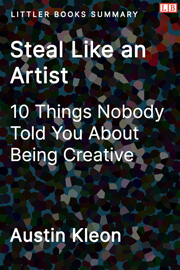Book Description
A manifesto on creativity that inspires readers to embrace their influences.
If You Just Remember One Thing
Creativity is not about pure originality, but about building upon ... More
Bullet Point Summary and Quotes
- Works of art are not created in isolation but rather built upon the legacy of past generations of artists. Great artists are not afraid to steal someone else's ideas. Artists like Picasso and Dali could be considered the biggest thieves of all time. Even The Beatles was first a cover band.
- Creativity is not about originality, but rather about recombination and synthesis. Creative work is similar to your DNA -- your genetics might be original but they came from your ancestors.
- To create great art, create an artistic family tree by finding an artist you admire and learn about those who influenced them.
- It's important to develop a creative routine and make time for creativity every day.
- Copying (not plagiarizing) someone else's work is a great way to start creating your own art. Imitating your heroes in every way possible, including their lifestyle and motivations, can help you find your niche.
- As you continue to copy your idols, you'll find there are areas where it's difficult for you to replicate what they did. Embrace these limitations because they are actually your strengths -- they are what make you unique. This process is called emulation, and it allows you to differentiate yourself from your idols while building upon their legacy.
- Examples of successful artists who started this way include Nick Cave (who emulated Leonard Cohen) and Conan O'Brien (who emulated David Letterman, who emulated Johnny Carson, who emulated Jack Benny), who initially copied their idols but eventually found their own distinctive style.
- As an artist, you may think that you need to give up your hobbies and side projects to focus entirely on your work, but this can actually hinder your productivity and happiness.
- Your hobbies and other projects provide you with an outlet when you encounter creative blocks, and they allow you to take a break and enjoy yourself. These side projects can also create the necessary mental space for innovation.
- The author discovered this when he felt empty after giving up playing the guitar to concentrate on art until he allowed himself to go back to the guitar for fun and felt happier and more well-rounded.
- Starting out as an artist, obscurity can benefit your career. Without any pressure or expectations, you have the creative freedom to make mistakes and find yourself.
- When you feel ready to gain recognition, sharing your work with others is the key to getting noticed. Create a blog or website, or post your work on online platforms to connect with your audience and build a following.
- To enhance creativity, artists should create a positive workspace that caters to every aspect of their creativity.
- It can be prohibitive to your creativity to only do work on the computer. Try working with your hands when possible.
- Artists should not become too complacent and should sometimes move to a new environment to gain new perspectives. The author benefited from living in Texas, England, and Italy.
- Creativity is a social activity. We are all part of a creative community and we should embrace collaboration, feedback, and criticism as a way to improve our work.
- The internet can be a double-edged sword for artists, as it can bring both praise and criticism. It is important not to let negativity discourage you. Engaging with critics is often a waste of time. Use criticism constructively and to fuel you.
- To make the most of the praise you receive, keep a praise file to encourage yourself. Remember to praise others as well, as positivity begets positivity.
- Take risks and embrace failure. Failure is a part of the creative process. You will not grow if you don't fail.
- Actively seek out new sources of inspiration to “steal” to create something new.
- Maintain a healthy perspective on creative work -- do not obsess over the result, you should focus on the process of creating and learn to enjoy the journey as much as the destination.
Steal Like an Artist: Resources
- Download this summary and 173+ other top nonfiction book summaries in one book (PDF, eBook, DOCX)
- Buy the book
